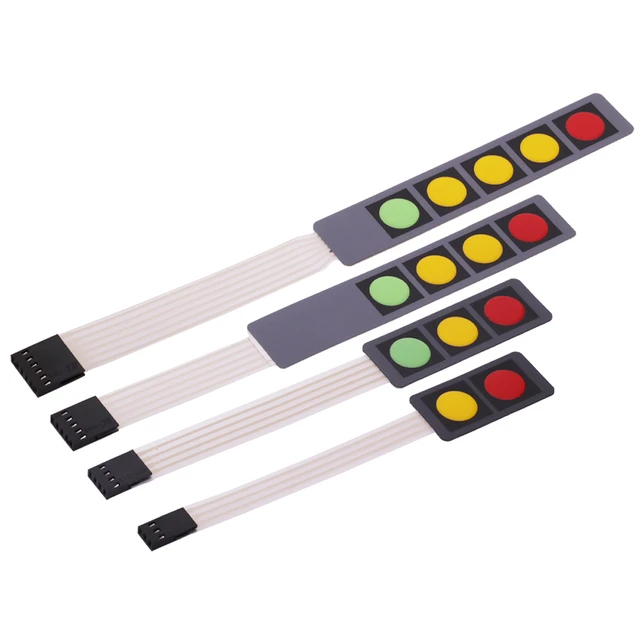Membrane Switch: Reliable, Cost-Effective, and User-Friendly Control Systems
Membrane Switch: Reliable, Cost-Effective, and User-Friendly Control Systems
Blog Article
Understanding Membrane Layer Switches: The Secret to Trustworthy and durable Controls

What Are Membrane Switches?
Membrane buttons are an innovative solution in the realm of interface modern technology, incorporating functionality and style effortlessly. These tools work as an interface between users and electronic systems, integrating a number of parts right into a portable format. Generally built from versatile, slim layers of products, membrane layer buttons are made to reply to touch, enabling individuals to engage with equipment and digital tools effectively.
The primary elements of a membrane switch include a printed circuit layer, visuals overlay, and a spacer layer that protects against unplanned activation. The graphic overlay can be customized to show brand name identity or individual preferences, improving aesthetics while ensuring usability. Membrane layer buttons are commonly utilized in numerous applications, consisting of medical devices, consumer electronic devices, and commercial tools, owing to their longevity and resistance to ecological aspects such as wetness and dust.
Among the vital benefits of membrane switches is their capacity to stand up to deterioration, making them perfect for high-traffic environments. Additionally, they are lightweight and call for very little area, permitting innovative designs in item advancement. In general, membrane layer switches represent a efficient and practical option for contemporary digital interfaces, marrying modern technology with user-centric style concepts.
Exactly How Membrane Layer Changes Job
The procedure of membrane changes joints on a basic yet effective device that translates customer input into electronic signals. These switches are composed of multiple layers, commonly including a visuals overlay, a spacer layer, and a circuit layer. When a user presses the switch, the leading layer deforms, enabling a conductive element in the circuit layer to reach an equivalent conductive pad on the bottom of the visuals overlay. This contact closes the circuit and sends out a digital signal to the gadget, showing that the switch has been turned on.
The design of membrane buttons can vary, however they commonly incorporate domes or tactile elements to supply responses to the customer, enhancing the overall experience - membrane switch. The materials utilized in membrane layer buttons, such as polyester or polycarbonate, add to their sturdiness and resistance to ecological variables, including moisture and dust. The printed circuits are normally enveloped, which shields them from wear and tear over time.
Advantages of Membrane Layer Buttons

In addition, membrane layer buttons are understood for their toughness. Built from durable materials, they are resistant to dust, wetness, and physical wear, which significantly extends their life expectancy compared to standard mechanical buttons. This durability makes them particularly suitable for high-traffic atmospheres and applications needing long life.
An additional significant benefit is the ease of cleansing and upkeep. The smooth surface area of membrane layer changes lessens dust build-up and is often unsusceptible spills, making them optimal for settings that require frequent sanitization.
Furthermore, membrane switches supply a structured profile, resulting in a thinner style that can be integrated right into different gadgets without adding bulk. This attribute not just improves the visual charm but additionally adds to an extra ergonomic product style.
Applications of Membrane Switches
Functional and straightforward, membrane read the full info here layer buttons find applications throughout a vast array of sectors, including clinical gadgets, customer electronics, and industrial equipment. In the clinical area, these switches are integral to tools such as diagnostic tools, person tracking systems, and infusion pumps, where dependability and simplicity of cleaning are this contact form crucial. Their ability to maintain and stand up to rough atmospheres functionality makes them optimal for such applications.

In customer electronic devices, membrane layer switches are used in items like microwaves, cleaning makers, and remote controls - membrane switch. Their smooth style enables instinctive user interfaces, improving the general individual experience while supplying longevity and resistance to damage
Commercial equipment additionally takes advantage of membrane buttons, specifically in control panels for machinery and automation systems. These buttons use security against dust and dampness, guaranteeing constant efficiency in challenging settings. Moreover, their customizable attributes permit producers to tailor them to particular operational requirements, enhancing efficiency and capability.
Choosing the Right Membrane Layer Change
When selecting a membrane layer switch, it is important to consider various aspects that influence efficiency and viability for certain applications. The key considerations consist of ecological problems, tactile responses, durability, and design requirements.
First, examine the operating environment; buttons subjected to moisture, chemicals, or severe temperatures need specific materials to ensure long life and functionality. Next, examine the requirement for tactile comments. Relying on individual communication, some applications might take advantage of a tactile action to confirm activation, while others might choose a non-tactile design for aesthetic reasons.
Longevity is an additional essential factor; membrane switches should be made to endure frequent usage, effects, and abrasion. Ensure the selected button can article source endure the expected lifecycle, particularly in high-usage circumstances.

Final Thought
In verdict, membrane switches offer as important components in the style of long lasting and reliable control systems across various markets. The convenience of membrane layer switches enables for customized services that satisfy particular functional needs, strengthening their value in modern-day technology.
Membrane changes stand for a crucial aspect of modern-day user interface layout, mixing performance with strength in different applications.Membrane switches are a sophisticated option in the world of customer interface technology, combining performance and layout effortlessly. Typically built from versatile, slim layers of products, membrane layer switches are made to respond to touch, allowing users to interact with equipment and digital devices efficiently.
The style of membrane layer switches can differ, yet they usually integrate domes or responsive elements to supply comments to the user, enhancing the overall experience.In final thought, membrane layer switches over serve as essential parts in the design of reliable and resilient control systems throughout different markets.
Report this page